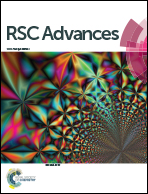Polymer brush functionalized Janus graphene oxide/chitosan hybrid membranes†
Abstract
A robust and simple method is reported to prepare polymer brush functionalized Janus graphene oxide (GO)/chitosan hybrid membranes via the combination of interface self-assembly of GO and chitosan, with subsequent self-initiated photografting and photopolymerization (SIPGP) from both sides of the GO/chitosan composite membrane.


 Please wait while we load your content...
Please wait while we load your content...